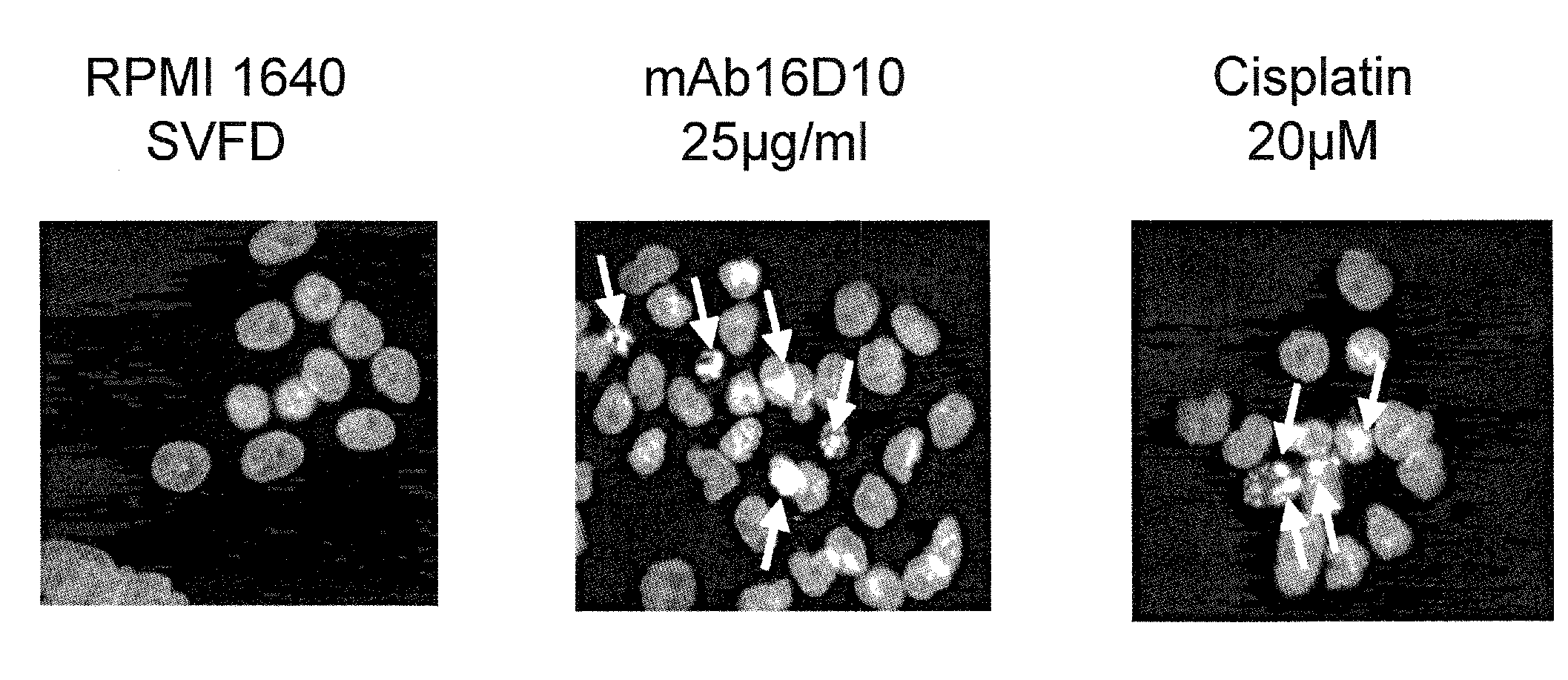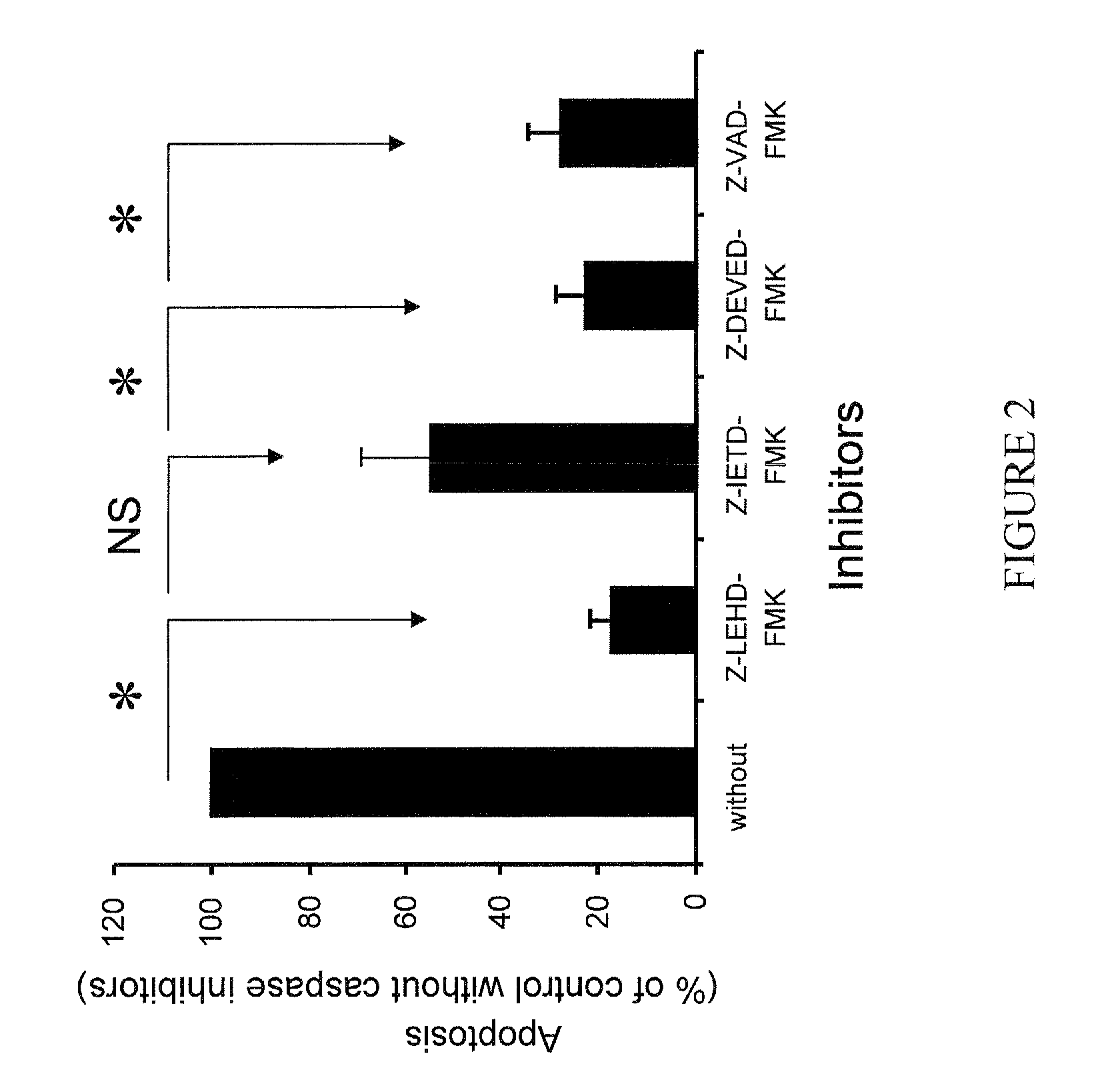Compositions and Methods for Treating Pancreatic Tumors
a technology of pancreatic cancer and compositions, applied in the field of glycopeptides, can solve the problems of ineffective inducing adcc, and achieve the effect of reducing the effect of proliferation or death and increasing the cell death of tumor cells
- Summary
- Abstract
- Description
- Claims
- Application Information
AI Technical Summary
Benefits of technology
Problems solved by technology
Method used
Image
Examples
example 1
Pancreatic SOJ-6 Cells Treated with mAb 16D10 Undergo Cellular Death by Apoptosis Over 24H
[0239]The ability of mAb16D10 to stimulate apoptotic cellular death of SOJ-6 cells was investigated as described herein. It was observed that antibody 16D10 leads to the apoptosis of SOJ-6 cells (compared to RPMI and mouse IgM, as shown in FIG. 1, the y-axis representing the number of apoptotic cells / cm2).
example 2
16D10 Induced Apoptosis is Mediated by Caspase-3, Caspase-8, and Caspase-9 Activation
[0240]In this experiment, apoptosis induced by 16D10 was measured with CaspAce FITC-VAD-fmk on Pancreatic SOJ-6 cells pre-treated with or without caspase inhibitors, (caspase 9: Z-LEHD-fmk, caspase8: Z-IEDT-fmk, caspase3: Z-DEVED-fmk, and caspase mix: Z-VAD-fink), and then treated with mAb16D10. FIG. 2 shows that mAb 16D10 stimulates apoptosis through the caspase-3, caspase-8, and caspase-9.
[0241]Apoptosis of SOJ-6 cells induced by mAb16D10 was also observed by DAPI staining. Results are shown in FIG. 3, where RPMI induced no apoptosis on cells, Cisplatin induced a low level of apoptosis, and antibody 16D10 induced significant levels of apoptosis, as observed by light coloration on cells in FIG. 3 corresponding to nuclear fragmentation.
example 3
16D10 is Controlled by the Bcl-2 Family of Proteins
[0242]Using SDS-PAGE and western blotting as described herein it was observed that treatment of cells with 16D10 induces a decrease of the anti-apoptotic protein Bcl-2 associated with an increase of Bax protein, indicating that the caspase activation is controlled by the Bcl-2 family of proteins. The experiment also demonstrated that 16D10-induced apoptosis is mediated via caspases 8 and 9, and poly-ADP ribose polymerase (PARP) cleavage. FIG. 4 shows the results on a gel, where in the leftmost lane represents SOJ-6 cells in RPMI, the middle lane represents SOJ-6 cells incubated with antibody 16D10, and the rightmost lane represents SOJ-6 cells incubated with cisplatin.
PUM
| Property | Measurement | Unit |
|---|---|---|
| size | aaaaa | aaaaa |
| diameter | aaaaa | aaaaa |
| pH | aaaaa | aaaaa |
Abstract
Description
Claims
Application Information
 Login to View More
Login to View More - R&D
- Intellectual Property
- Life Sciences
- Materials
- Tech Scout
- Unparalleled Data Quality
- Higher Quality Content
- 60% Fewer Hallucinations
Browse by: Latest US Patents, China's latest patents, Technical Efficacy Thesaurus, Application Domain, Technology Topic, Popular Technical Reports.
© 2025 PatSnap. All rights reserved.Legal|Privacy policy|Modern Slavery Act Transparency Statement|Sitemap|About US| Contact US: help@patsnap.com



